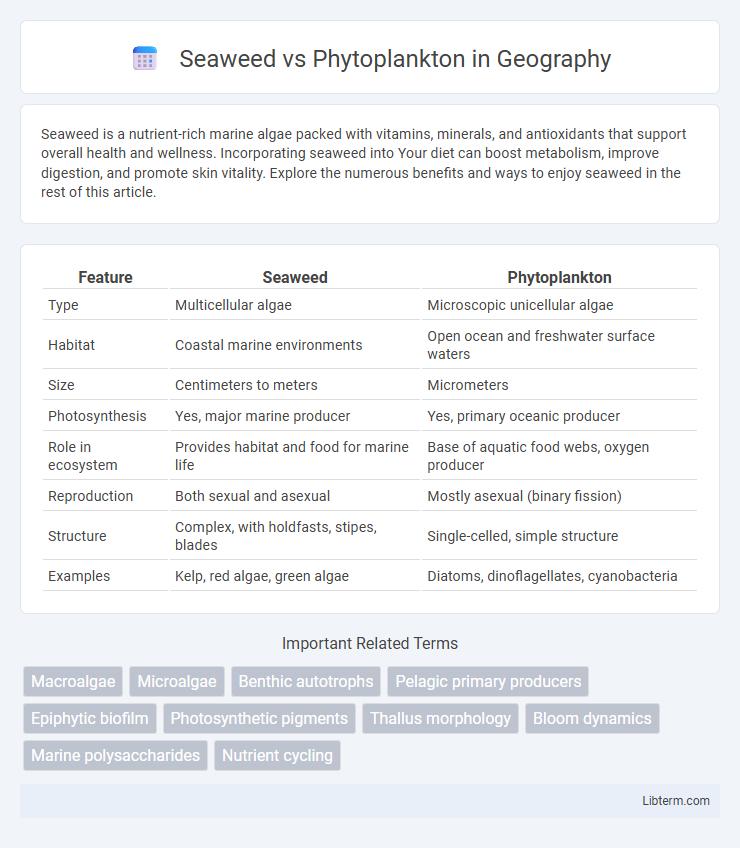Seaweed is a nutrient-rich marine algae packed with vitamins, minerals, and antioxidants that support overall health and wellness. Incorporating seaweed into Your diet can boost metabolism, improve digestion, and promote skin vitality. Explore the numerous benefits and ways to enjoy seaweed in the rest of this article.
Table of Comparison
| Feature | Seaweed | Phytoplankton |
|---|---|---|
| Type | Multicellular algae | Microscopic unicellular algae |
| Habitat | Coastal marine environments | Open ocean and freshwater surface waters |
| Size | Centimeters to meters | Micrometers |
| Photosynthesis | Yes, major marine producer | Yes, primary oceanic producer |
| Role in ecosystem | Provides habitat and food for marine life | Base of aquatic food webs, oxygen producer |
| Reproduction | Both sexual and asexual | Mostly asexual (binary fission) |
| Structure | Complex, with holdfasts, stipes, blades | Single-celled, simple structure |
| Examples | Kelp, red algae, green algae | Diatoms, dinoflagellates, cyanobacteria |
Introduction to Seaweed and Phytoplankton
Seaweed, a multicellular marine algae, plays a critical role in coastal ecosystems by providing habitat and contributing to carbon sequestration. Phytoplankton, microscopic single-celled organisms, form the foundation of the oceanic food chain through photosynthesis, producing nearly half of the world's oxygen. Both seaweed and phytoplankton are essential for marine biodiversity and global biogeochemical cycles.
Key Differences in Structure and Habitat
Seaweed is a multicellular marine algae with complex structures including holdfasts, stipes, and blades, while phytoplankton are primarily unicellular or colonial microscopic organisms floating freely in aquatic environments. Seaweed typically attaches to rocky substrates in coastal areas, thriving in the photic zone where sunlight penetration supports photosynthesis, whereas phytoplankton drift in open oceans, lakes, and rivers, forming the base of aquatic food webs through photosynthetic activity. The distinct structural complexity and habitat preferences highlight their different ecological roles in marine ecosystems.
Nutritional Value Comparison
Seaweed and phytoplankton both offer rich nutritional profiles, with seaweed providing a significant source of dietary fiber, iodine, vitamins A, C, E, and K, as well as minerals like calcium and iron. Phytoplankton, microscopic marine algae, are dense in omega-3 fatty acids, proteins, chlorophyll, and antioxidants, making them a potent superfood for cellular health and energy. While seaweed is widely consumed for its mineral content and fiber, phytoplankton stands out for its concentrated fatty acids and bioactive compounds essential for brain and heart function.
Ecological Roles in Marine Ecosystems
Seaweed and phytoplankton play critical ecological roles in marine ecosystems by supporting food webs and global biogeochemical cycles. Seaweed, as large macroalgae, provides habitat, nursery grounds, and oxygen through photosynthesis, while phytoplankton, microscopic photosynthetic organisms, form the base of marine food chains and drive primary production, contributing significantly to carbon sequestration and oxygen generation. Both groups influence nutrient cycling, with phytoplankton affecting surface ocean nutrient dynamics and seaweed stabilizing coastal sediments and coastal biodiversity.
Benefits for Human Consumption
Seaweed offers rich sources of essential minerals like iodine and calcium, supporting thyroid function and bone health, while phytoplankton provides high levels of omega-3 fatty acids critical for cardiovascular and brain health. Both seaweed and phytoplankton contain antioxidants and vitamins that enhance immune response and reduce inflammation. Incorporating these marine superfoods into diets can improve nutrient intake, promote metabolic wellness, and contribute to sustainable food sources.
Impact on Climate and Carbon Sequestration
Seaweed and phytoplankton both play crucial roles in climate regulation and carbon sequestration through their ability to absorb CO2 during photosynthesis. Seaweed, particularly large macroalgae, sequesters carbon by transferring it to deep ocean sediments when they die and sink, providing long-term storage. Phytoplankton contributes to the biological carbon pump by fixing carbon and transporting it to the ocean floor through sedimentation of organic matter, significantly influencing global carbon cycles and mitigating climate change.
Cultivation and Harvesting Methods
Seaweed cultivation typically involves sea-based farms where ropes and nets are anchored to the ocean floor, allowing kelp and other macroalgae to grow in nutrient-rich waters, facilitating scalable harvesting through mechanized or manual cutting. Phytoplankton cultivation is primarily conducted in controlled environments such as photobioreactors or open ponds, optimizing light, nutrient supply, and CO2 levels to enhance microalgal biomass production, with harvesting methods relying on centrifugation, filtration, or flocculation to efficiently collect the microscopic cells. These distinct cultivation and harvesting techniques reflect the size and habitat differences between macroalgae (seaweed) and microalgae (phytoplankton), impacting their respective applications in biofuels, food products, and bioproducts.
Commercial Uses and Applications
Seaweed, rich in alginates, carrageenan, and agar, is extensively used in food processing, cosmetics, pharmaceuticals, and biofertilizers, while phytoplankton's primary commercial applications include biofuel production, nutritional supplements, and carbon sequestration technologies. The cultivation of seaweed supports sustainable aquaculture industries and produces raw materials for biodegradable packaging and animal feed. Phytoplankton's rapid growth rates and high lipid content make it a promising resource for renewable energy and omega-3 fatty acid supplements.
Environmental Concerns and Sustainability
Seaweed cultivation enhances carbon sequestration and reduces ocean acidification, offering sustainable benefits without depleting marine nutrients, while phytoplankton blooms can cause harmful algal blooms and oxygen depletion when imbalanced. Seaweed farms require less freshwater and fertilizers compared to terrestrial crops, minimizing environmental footprints, whereas phytoplankton growth is highly sensitive to ocean temperature and pollution levels. Sustainable seaweed farming offers a scalable solution for mitigating climate change impacts, in contrast to the challenges of managing phytoplankton-driven ecosystem disruptions.
Future Trends and Research Directions
Emerging research highlights the potential of seaweed and phytoplankton as sustainable bioresources for carbon sequestration, biofuel production, and nutrient cycling, positioning them at the forefront of climate change mitigation strategies. Advances in genetic engineering aim to enhance growth rates and biochemical compositions, optimizing these organisms for pharmaceutical and food industry applications. Future trends include integrated aquaculture systems that combine seaweed and phytoplankton cultivation to maximize ecosystem services and economic viability.
Seaweed Infographic

 libterm.com
libterm.com